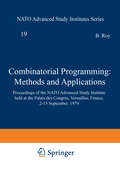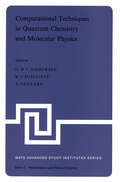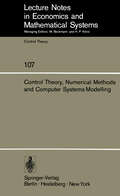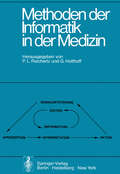- Table View
- List View
Classification Theory of Algebraic Varieties and Compact Complex Spaces (Lecture Notes in Mathematics #439)
by K. UenoCombinatorial Programming: Proceedings of the NATO Advanced Study Institute held at the Palais des Congrès, Versailles, France, 2–13 September, 1974 (Nato Science Series C: #19)
by B. Roy"Combinatorial Programming" are two words whose juxtaposition still strike us as unusual, nevertheless their association in recent years adequately reflects the preoccupations underlying differing work fields, and their importance will increase both from methodology and application view points. To those who like definitions and consider the function of this book to furnish one for combinatorial programming, I will simply say that it is precise ly this which is exclusively treated here and which in the eyes of the autors is the heart of this branch of applied mathematics. Such was the initial intention of those who in the spring of 1973 gathered tog~ther in Paris to state the work of the Advanced Study Institute from which this book arises. As young as combinatorial programming is, it was easy to see that a two week school was insufficient to cover the subject in an exhaustive manner. Finally the decision had to be taken to reduce to book form, and to organise within this particular means of expression, the essential syntheses and communications. Unfortunately the discussions, the round tables, and the majority of the case studies could not be included in this book which is more of a hand-book on the subject. XIV PREFACE The choice and orientation of the surveys has been guided by two criteria : the importance of already accomplished work, and the originality of the survey to be undertaken.
Computational Mechanics: International Conference on Computational Methods in Nonlinear Mechanics, Austin, Texas, 1974 (Lecture Notes in Mathematics #461)
by J. T. OdenComputational Techniques in Quantum Chemistry and Molecular Physics: Proceedings of the NATO Advanced Study Institute held at Ramsau, Germany, 4–21 September, 1974 (Nato Science Series C: #15)
by Geerd H. F. Diercksen B. T. Sutcliffe A. VeillardThis book contains the transcripts of the lectures presented at the NATO Advanced study Institute on "Computational Techniques in Quantum Chemistry and Molecular Physics", held at Ramsau, Germany, 4th - 21st Sept. 1974. Quantum theory was developed in the early decades of this century and was first applied to problems in chemistry and molecular physics as early as 1927. It soon emerged however, that it was impossible to con sider any but the simplest systems in any quantita tive detail because of the complexity of Schrodinger's equation which is the basic equation for chemical and molecular physics applications. This remained the si tuation until the development, after 1950, of elec tronic digital computers. It then became possible to attempt approximate solutions of Schrodinger's equa tion for fairly complicated systems, to yield results which were sufficiently accurate to make comparison with experiment meaningful. Starting in the early nineteen sixties in the United States at a few centres with access to good computers an enormous amount of work went into the development and implementation of schemes for approximate solu tions of Schrodinger's equation, particularly the de velopment of the Hartree-Fock self-consistent-field scheme. But it was soon found that the integrals needed for application of the methods to molecular problems are far from trivial to evaluate and cannot be easily approximated.
Control Theory, Numerical Methods and Computer Systems Modelling: International Symposium, Rocquencourt, June 17–21, 1974 (Lecture Notes in Economics and Mathematical Systems #107)
by J. L. Lions A. BensoussanDarstellungssätze für beschränkte lineare Funktionale im Zusammenhang mit Hausdorff-, Stieltjes- und Hamburger-Momentenproblemen (Forschungsberichte des Landes Nordrhein-Westfalen #2515)
by Paul L. ButzerDesign of Digital Computers: An Introduction (Monographs in Computer Science)
by Hans W. Gschwind E.J. McCluskeyI have been using the first edition of this book as a text for a number of years. This was in a Stanford University first-year graduate course that is taken by students from Electrical Engineering or Computer Science who are interested in computer organization. Because computer tech nology has been changing so rapidly, it became necessary to supplement the text with additional readings. My colleagues and I examined many newly-published books for possible use as texts. We found no book with the same excellent choice of topics and thorough coverage as Dr. Gschwind's first edition. Springer-Verlag's request that I prepare a second edition of this book came at a time when I had many other projects underway. Before I de cided whether to take on the project of preparing a revision, I asked many of my students for their opinions of Dr. Gschwind's first edition. Even I was surprised by the enthusiasm that this rather skeptical and critical group of students displayed for the book. It was this enthusiasm that convinced me of the value and importance of preparing the revision.
Digitale Datenverarbeitung für das technische Studium (Viewegs Fachbücher der Technik)
by Harald SchumnyEncyclopedia of Computer Science and Technology: Volume 2 - AN/FSQ-7 Computer to Bivalent Programming by Implicit Enumeration (Computer Science And Technology Encyclopedia Ser.)
by Jack Belzer"This comprehensive reference work provides immediate, fingertip access to state-of-the-art technology in nearly 700 self-contained articles written by over 900 international authorities. Each article in the Encyclopedia features current developments and trends in computers, software, vendors, and applications...extensive bibliographies of leading figures in the field, such as Samuel Alexander, John von Neumann, and Norbert Wiener...and in-depth analysis of future directions."
Encyclopedia of Computer Science and Technology: Volume 2 - AN/FSQ-7 Computer to Bivalent Programming by Implicit Enumeration (Computer Science And Technology Encyclopedia Ser.)
by Jack Belzer"This comprehensive reference work provides immediate, fingertip access to state-of-the-art technology in nearly 700 self-contained articles written by over 900 international authorities. Each article in the Encyclopedia features current developments and trends in computers, software, vendors, and applications...extensive bibliographies of leading figures in the field, such as Samuel Alexander, John von Neumann, and Norbert Wiener...and in-depth analysis of future directions."
GI-4.Jahrestagung: Berlin, 9.–12. Oktober 1974 (Lecture Notes in Computer Science #26)
by Dirk SiefkesInformatik: Aufgaben und Lösungen Erster Teil (Heidelberger Taschenbücher #159)
by F. L. Bauer R. Gnatz U. HillDie hier vorgelegte Sammlung von Aufgaben und Lösungen ergänzt das Lehrbuch ,Informatik. Eine einführende Übersicht' von F. L. BAUER und G. Goos, Heidelberger Taschenbücher Bd. 80, 91. Die Anordnung entspricht kapitelweise der Anordnung im Lehrbuch, die· weitere Unterteilung ist hauptsächlich durch didaktische Gesichts punkte bestimmt. Die Aufgaben sind großenteils an der TU München in Tutor übungen behandelt worden. Sie dienen in der Regel dazu, die in der Vorlesung ein geführten Begriffsstrukturen auszufüllen und zu festigen; dies gilt insbesondere für die Programmierungsaufgaben, bei denen der banale Nebenzweck, die Gewöhnung an eine formale Notation, nicht in den Vordergrund treten soll. Häufig bringen die Aufgaben auch Ergänzungen und Vertiefungen des Stoffes. Im Charakter der Auf gaben haben wir uns bemüht, Abwechslung zu zeigen. Wenig Raum haben wir dabei dem Typ von Aufgaben gegeben, der so fatalerweise an ,programmiertes Lernen' er innert: Aufgaben, bei denen man mit Ja oder Nein antworten kann; oder Aufgaben, bei denen etwa von fünf vorgelegten Programmfassungen herauszufinden ist, welche Fassungen, wenn überhaupt, richtig sind. Solche Aufgaben regen den Geist nicht an, von intelligenten Studenten werden sie leicht als Quälerei aufgefaßt. Sie mögen ge eignet sein, um im Selbststudium oder im Tutorunterricht mechanisch zu überprüfen, ,ob man mitkommt', und deshalb ihren Platz haben in einer modemen Didaktik des Massenstudiums. Sie sind unschwer zu konstruieren, und die wenigen Beispiele, die wir bringen, mögen als Anhaltspunkte dienen. Dies gilt übrigens für alle Aufgaben: Sie sollen auch zu abgewandelten und neuen AufgabensteIlungen anregen.
Information Theory New Trends and Open Problems (CISM International Centre for Mechanical Sciences #219)
by G. LongoInterval Mathematics: Proceedings of the International Symposium Karlsruhe, West Germany, May 20-24, 1975 (Lecture Notes in Computer Science #29)
by K. NickelMethoden der Informatik in der Medizin: Bericht der 3. hannoverschen Tagung über Medizinische Informatik vom 28.–30. März 1974
by P. L. Reichertz G. HolthoffNonlinear and Dynamic Programming: An Introduction
by S. DanoThis book is intended to provide an introductory text of Nonlinear and Dynamic Programming for students of managerial economics and operations research. The author also hopes that engineers, business executives, managers, and others responsible for planning of industrial operations may find it useful as a guide to the problems and methods treated, with a view to practical applications. The book may be considered as a sequel to the author's Linear Programming in Industry (1960, 4th revised and enlarged edition 1974), but it can be used independently by readers familiar with the elements of linear programming models and techniques. The two volumes con stitute an introduction to the methods of mathematical programming and their application to industrial optimization problems. The author feels that the vast and ever-increasing literature on mathematical programming has not rendered an introductory exposition super fluous. The general student often tends to feel somewhat lost if he goes straight to the special literature; he will be better equipped for tackling real problems and using computer systems if he has acquired some previous training in constructing small-scale programming models and applying standard algorithms for solving them by hand. The book is intended to provide this kind of training, keeping the mathematics at the necessary minimum. The text contains numerous exercises. The reader should work out these problems for himself and check with the answers given at the end of the book. The text is based on lectures given at the University of Copenhagen.























